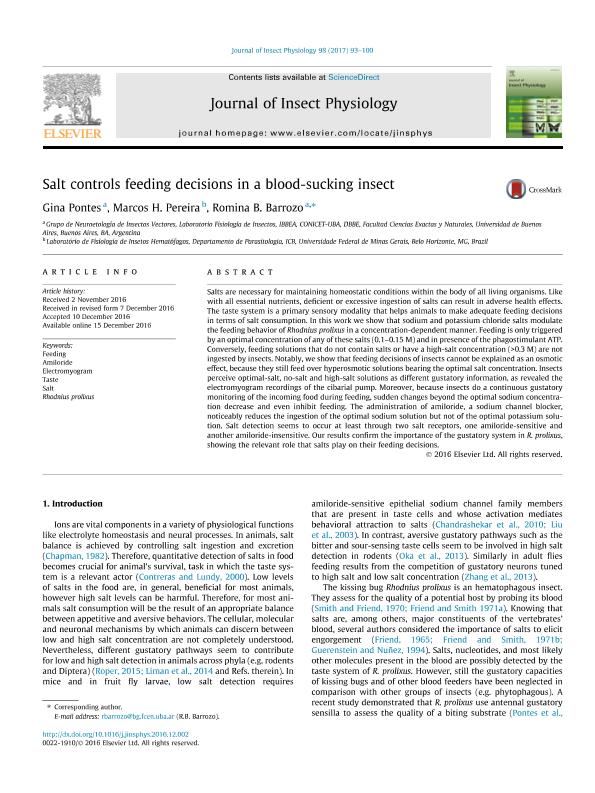Mostrar el registro sencillo del ítem
dc.contributor.author
Barcelos Pontes, Gina

dc.contributor.author
Pereira, Marcos H.
dc.contributor.author
Barrozo, Romina

dc.date.available
2017-07-04T20:12:22Z
dc.date.issued
2017-04
dc.identifier.citation
Barcelos Pontes, Gina; Pereira, Marcos H.; Barrozo, Romina; Salt controls feeding decisions in a blood-sucking insect; Elsevier; Journal of Insect Physiology; 98; 4-2017; 93-100
dc.identifier.issn
0022-1910
dc.identifier.uri
http://hdl.handle.net/11336/19516
dc.description.abstract
Salts are necessary for maintaining homeostatic conditions within the body of all living organisms. Like with all essential nutrients, deficient or excessive ingestion of salts can result in adverse health effects. The taste system is a primary sensory modality that helps animals to make adequate feeding decisions in terms of salt consumption. In this work we show that sodium and potassium chloride salts modulate the feeding behavior of Rhodnius prolixus in a concentration-dependent manner. Feeding is only triggered by an optimal concentration of any of these salts (0.1–0.15 M) and in presence of the phagostimulant ATP. Conversely, feeding solutions that do not contain salts or have a high-salt concentration (>0.3 M) are not ingested by insects. Notably, we show that feeding decisions of insects cannot be explained as an osmotic effect, because they still feed over hyperosmotic solutions bearing the optimal salt concentration. Insects perceive optimal-salt, no-salt and high-salt solutions as different gustatory information, as revealed the electromyogram recordings of the cibarial pump. Moreover, because insects do a continuous gustatory monitoring of the incoming food during feeding, sudden changes beyond the optimal sodium concentration decrease and even inhibit feeding. The administration of amiloride, a sodium channel blocker, noticeably reduces the ingestion of the optimal sodium solution but not of the optimal potassium solution. Salt detection seems to occur at least through two salt receptors, one amiloride-sensitive and another amiloride-insensitive. Our results confirm the importance of the gustatory system in R. prolixus, showing the relevant role that salts play on their feeding decisions.
dc.format
application/pdf
dc.language.iso
eng
dc.publisher
Elsevier

dc.rights
info:eu-repo/semantics/openAccess
dc.rights.uri
https://creativecommons.org/licenses/by-nc-nd/2.5/ar/
dc.subject
Amiloride
dc.subject
Electromyogram
dc.subject
Feeding
dc.subject
Rhodnius Prolixus
dc.subject
Salt
dc.subject
Taste
dc.subject.classification
Zoología, Ornitología, Entomología, Etología

dc.subject.classification
Ciencias Biológicas

dc.subject.classification
CIENCIAS NATURALES Y EXACTAS

dc.title
Salt controls feeding decisions in a blood-sucking insect
dc.type
info:eu-repo/semantics/article
dc.type
info:ar-repo/semantics/artículo
dc.type
info:eu-repo/semantics/publishedVersion
dc.date.updated
2017-07-04T15:34:28Z
dc.journal.volume
98
dc.journal.pagination
93-100
dc.journal.pais
Países Bajos

dc.journal.ciudad
Amsterdam
dc.description.fil
Fil: Barcelos Pontes, Gina. Consejo Nacional de Investigaciones Científicas y Técnicas. Oficina de Coordinación Administrativa Ciudad Universitaria. Instituto de Biodiversidad y Biología Experimental y Aplicada. Universidad de Buenos Aires. Facultad de Ciencias Exactas y Naturales. Instituto de Biodiversidad y Biología Experimental y Aplicada; Argentina
dc.description.fil
Fil: Pereira, Marcos H.. Universidade Federal do Minas Gerais; Brasil
dc.description.fil
Fil: Barrozo, Romina. Consejo Nacional de Investigaciones Científicas y Técnicas. Oficina de Coordinación Administrativa Ciudad Universitaria. Instituto de Biodiversidad y Biología Experimental y Aplicada. Universidad de Buenos Aires. Facultad de Ciencias Exactas y Naturales. Instituto de Biodiversidad y Biología Experimental y Aplicada; Argentina
dc.journal.title
Journal of Insect Physiology

dc.relation.alternativeid
info:eu-repo/semantics/altIdentifier/doi/http://dx.doi.org/10.1016/j.jinsphys.2016.12.002
dc.relation.alternativeid
info:eu-repo/semantics/altIdentifier/url/http://www.sciencedirect.com/science/article/pii/S0022191016303742
Archivos asociados
